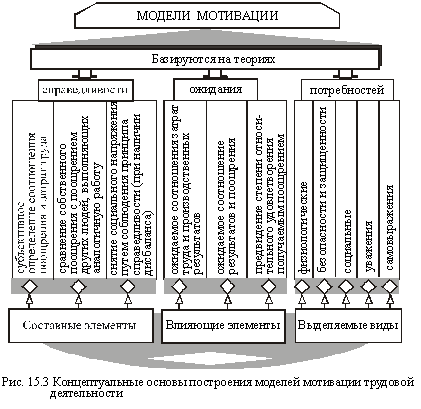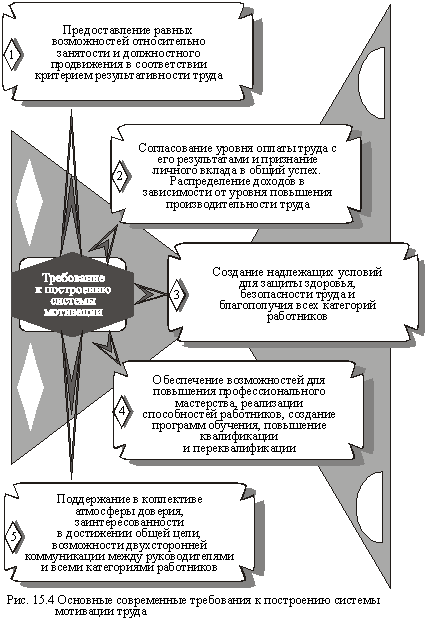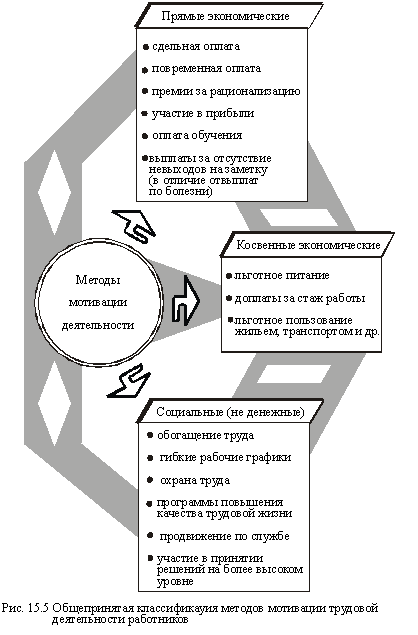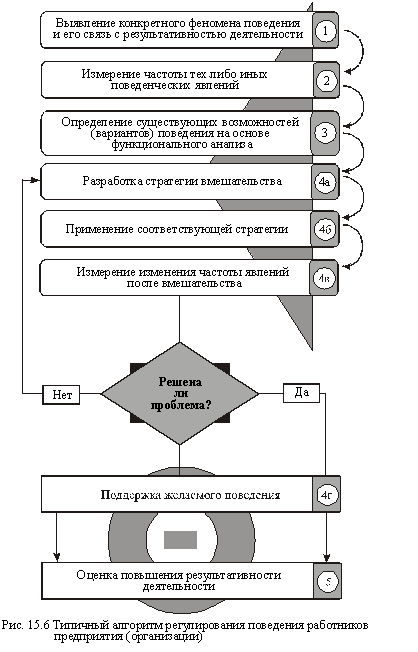home
 Economy Economy
 Economy of the enterprise - Pokropivny SF Economy of the enterprise - Pokropivny SF
|
Economy of the enterprise - Pokropivny SF
15.2. Motivation of labor activity
System, models and methods of motivation
The social and economic basis for intensifying the efforts of the personnel of enterprises (organizations) aimed at increasing the effectiveness of their activities is always the motivation of labor.
In order to form an appropriate attitude to work, it is necessary to create such conditions that the staff perceive their work as a conscious activity that is the source of self-improvement, the basis of professional and service growth. The motivation system should develop a sense of belonging to a particular organization. The corresponding attitude to work and conscious behavior are determined by the employee's values system, working conditions and applied incentives. With the dominant role of social and economic conditions, the psychological aspects are first laid the foundation for any model of motivation (Figure 15.3.).
The influence of the controlling subsystem of the enterprise on the factors of the employee's behavior depends on the knowledge of the elements not only of individual psychology that determines the actions of each worker, but also the collective psychology of certain groups of workers. This explains the perception of motivation as a probabilistic process: what motivates one worker in a particular situation, will not influence him in another situation, or will not affect another employee under similar working conditions. This explains the need to design multi-factor motivation models that take into account the needs, expectations and perceptions of various employees for their work.

The performance of a particular employee is determined primarily by individual opportunities and personal interest, as well as by the awareness of his own role in collective efforts. The amount of labor costs depends on the employee's assessment of the adequacy of the level of remuneration and the certainty that it will be received.
The factors that determine the behavior of an employee and require the consideration of motivation in their work are, first of all, the following: the physical type of the person (age, gender, etc.), the level of self-awareness and education, vocational training, the psychological climate in the team, the influence of the environment etc.
As for collective psychology, the formation of an effective system of motivation is based on the constant analysis and improvement of relations between: employers and employees; Leaders and their subordinates; Competing working groups performing similar functions.
The system of motivation at the enterprise level should be based on certain requirements. The main ones are shown in Fig. 15.4.
In the practice of management the general production classification of methods of motivation is applied. Possible methods of motivating the performance of employees of any enterprise are listed in Fig. 15.5.
In addition to the generally accepted classification of methods of motivation, they are also divided into individual and group methods, as well as external ones (reward for successes achieved) and internal (when reward is labor itself, giving the employee a sense of social significance, self-esteem, etc.).
In the theory of motivation, the term "reward" has a broader meaning than simply money or moral satisfaction, with which this word is most often associated. Reward is all that a person considers to be valuable for himself. But the understanding of values among people is not the same, and therefore their assessment of the relative level of remuneration will be different. Personalization (individual or group) of forms and methods of reward is the key to the effectiveness of any model of motivation, although purely material needs will dominate the society for a long time.


Principles and procedure for regulating the behavior of employees
At the same time, it should be noted that wages can not be a single goal of labor activity. Material incentive makes the motivation of labor productive only if the latter is functioning as a system based on such basic principles:
- Communication, cooperation and agreement between the employees and the administration of the firm regarding the general principles of the system;
- A sound system for assessing the work and determining the volume of the latter;
- Well-founded criteria for measuring and evaluating labor expended; Weighted labor standards, monitoring of them, periodic review, clear coordination of incentives with performance; Remuneration (especially additional) not for the level of performance in general, but for the level that is primarily related to the quality of products (services).
Current changes in the activities of the enterprise, its individual divisions, as well as the development and implementation of a strategy for further development, often require adjusting (regulating) the behavior of certain categories of workers.
Regulation of the behavior of employees consists in identifying functional and desirable behaviors and reinforcing those that are appropriate motivation.
The fundamental principles related to the regulation of people's behavior include the following:
- Firstly, the need to take into account only behavioral phenomena that are actually possible in specific conditions of activity;
- Secondly, the use of the frequency of manifestation of these behavioral phenomena in the relevant group of workers as the main indicators;
- Thirdly, constant supervision and control of the behavior of employees in the context of a specific situation at the enterprise (in the organization).
A consistently implemented algorithm for regulating the behavior of certain categories of personnel in an enterprise (organization), depending on the performance of the activity, is shown in Fig. 15.6.

As you can see, the algorithm has a universal character and provides for 5 steps (stages) of regulation: 1) identification; 2) measurement; 3) analysis; 4) interference; 5) evaluation. The unit of analysis can be either an individual or a group of people. But in any case, the success of so-called situational behavior management largely depends on identifying the causal relationship between behavior and performance, between corrective actions and increasing the efficiency of the enterprise.


Comments
When commenting on, remember that the content and tone of your message can hurt the feelings of real people, show respect and tolerance to your interlocutors even if you do not share their opinion, your behavior in the conditions of freedom of expression and anonymity provided by the Internet, changes Not only virtual, but also the real world. All comments are hidden from the index, spam is controlled.